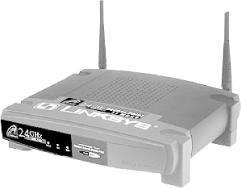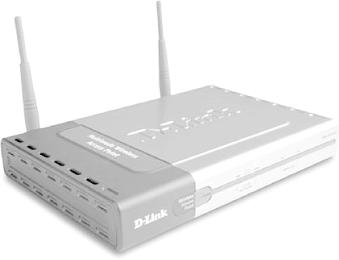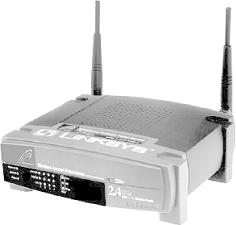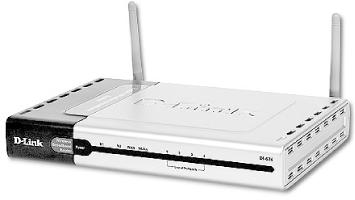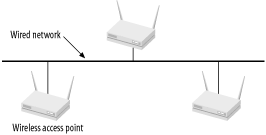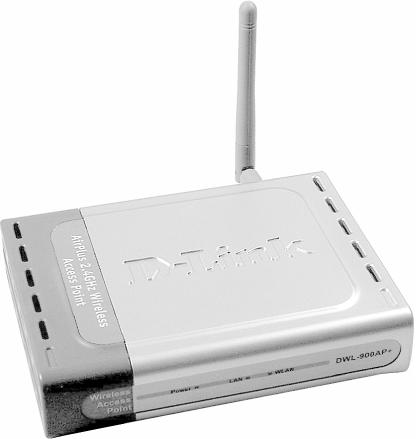So far you have been learning about how wireless networks work and how to connect to one. In this chapter, I show you how to deploy a wireless network yourself. I illustrate this using two different wireless access points and considering how they might be used in two different environments—one at home and another in the office. Of course, many home users will have needs that are closer to that of an office, and some small offices may have needs closer to that of a home user. For the purposes of these examples, the home environment is assumed to have consumer-level broadband access, while the office environment is assumed to have a more extensive wired network in place.
The cost for setting up a wireless network has, over the years, been lowered substantially. Today, you can easily set up a wireless network at home for about $200. For that amount, you can get a wireless access point, a wireless PC card (for your notebook), and a USB wireless adapter (for your desktop).
Tip
In this section, I am assuming you want your wireless users to access the Internet. If your aim is to simply connect two machines wirelessly, you do not need a DSL/ADSL modem and wireless access point. All you need is a wireless adapter or card for each computer. See Section 5.5 later in this chapter.
To set up your own wireless network, you need the following:
Tip
Some ISPs, in an attempt to discourage multiple computers from sharing the Internet connection, will bundle a USB-port modem when you sign up for the broadband package. In order to connect a router to your ISP, you’ll need to purchase a separate modem with an Ethernet port that is compatible with your ISP. Check with your ISP to obtain a list of compatible modems.
A typical wireless home/office setup is shown in Figure 5-1 (note that the PC with Ethernet connection is optional).
A wireless access point is a wireless device that routes traffic in a wireless network. It is usually attached to an existing wired network, or to a Wide Area Network (WAN) connection such as a cable or DSL/ADSL modem. Basically, the purpose of the wireless access point is to provide a centralized location for exchanging wireless traffic sent by wireless devices. Wireless access points generally come in two flavors:
Pure wireless access point
Wireless access point with router functionality
A pure wireless access point simply comes with an Ethernet connector for connecting to a wired network. This is suitable for situations where you already have an established network and simply want to enable wireless access to it. It relies on your network to provide DHCP (Dynamic Host Configuration Protocol — a protocol that assigns IP addresses to clients) services, and hence is not suitable in environments in which a single IP address is usually allocated, such as in a home network. A pure wireless access point is little more than a virtual wire that connects your unwired computers to whatever networking hardware you’ve plugged the access point into.
Figure 5-2 shows the Linksys WAP11 Wireless Access Point.
Tip
If you’re connecting an access point to an ISP, you should check with your ISP to see if it will allocate more than one IP address. If only one IP address is allocated, you will need a router with DHCP services to allow multiple computers to connect to the Internet. In such a configuration, your router will grab that one IP address and use Network Address Translation (NAT) to share that address with the rest of your network (see DHCP and NAT, later in this chapter). Even if your ISP offers more than one IP address, you should go with a wireless access point that has firewall capabilities, which nearly always go hand-in-hand with router capabilities. You will only pay a little bit more for a router, but the peace of mind that comes with a firewall is well worth it.
Figure 5-3 shows the back of the Linksys WAP11.
At the moment, there are three prevailing wireless standards: 802.11b, 802.11a, and 802.11g (see Chapter 2). Figure 5-4 shows the D-Link DWL-6000AP Multimode Wireless Access Point that supports both the 802.11a and 802.11b wireless standards.
Besides the 802.11a wireless access points, vendors are also launching new 802.11g wireless access points based on the 802.11g specifications. Figure 5-5 shows the Linksys WAP54G Wireless Access Point that supports both the 802.11b and 802.11g wireless standards.
A wireless access point with router functionality, on the other hand, provides routing services in addition to being a wireless access point. It comes with a port for connecting to the WAN, and it also usually comes with a multiport switch for wired connections (see Figure 5-6). Most routers support DHCP and come with NAT services (see DHCP and NAT later in this chapter for more information). As such, a wireless access point with router functionality is useful in situations in which only a single IP address is allocated, or in which a router’s firewall services are needed. Most DSL/ADSL and cable connections are allocated a single IP address, effectively enabling only a single machine to connect at any one time. With a wireless router, multiple computers can connect to the Internet simultaneously.
Figure 5-6. The back of a wireless access point with router functionality (photo courtesy of Linksys)
Figure 5-7 shows the Linksys BEFW11SE Wireless Access Point with a 4-port switch.
Figure 5-7. The Linksys BEFW11SE Wireless Access Point with 4-port switch (802.11b) (photo courtesy of Linksys)
For 802.11g, D-Link has the DI-624, as shown in Figure 5-8.
If you have a traditional wired network in your office or home environment, you can enable wireless access by installing a wireless access point in your network. For a physically large access area, you can use multiple access points. Figure 5-9 shows three wireless access points connected to a wired network.
These wireless access points might all be configured with the same Service Set Identifier (SSID) or with different SSIDs. If their ranges overlap with one another’s, you may get a more reliable signal by assigning each one to a different channel (see Section 2.2.3 in Chapter 2 and Section 3.2.1.3 in Chapter 3).
Tip
If users need to roam from one access point to another, it is recommended that all the access points be configured with the same SSID. If not, the user may not be able to move from one access point to another unless they configure their computers to accept different SSIDs. Windows XP Wireless Zero Configuration in Chapter 2 explains how to configure your computer to accept different SSIDs.
In general, Windows XP automatically detects the SSIDs of the wireless networks, unless the access point turns off SSID broadcast. Please refer to Chapter 4 for more information on turning off SSID broadcast.
Every wireless access point has a limited operating range. To extend the effective range of a wireless network, you can use a wireless repeater. There aren’t many standalone wireless repeaters in the market, but some wireless access points double as a repeater. Figure 5-10 show how a wireless repeater can extend the effective range of a wireless network.
Tip
You need to use compatible wireless access points with the repeater you are using. In other words, you would most likely buy the equipment from the same vendors.
A wireless repeater does not need to connect to any part of the wired network. Basically it receives a signal from a wireless access point and retransmits it, essentially extending the range of the wireless network.
The D-Link AirPlus DWL-900AP+ Wireless Access Point is one such access point that includes a repeating function (see Figure 5-11).
Another use of wireless access points is to bridge devices to connect two wired networks. Figure 5-12 shows this scenario.
Two wired networks may be physically separated but can be linked using two wireless access points operating in bridge mode. The D-Link DWL-900AP+ supports this bridge mode.


